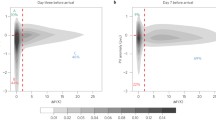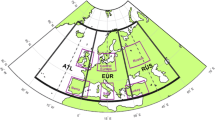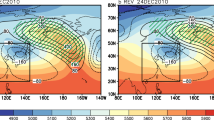Abstract
Atmospheric blocking represents an important aspect of the mid-latitude weather variability, but the different processes contributing to its formation and maintenance are not yet fully understood. This study investigates the role that diabatic processes, in particular the release of latent heating in strongly ascending airstreams, play in the dynamics and spatio-temporal variability of blocking in a detailed 38-year global climatological analysis. The results show that the formation and (re-)intensification of blocking are often preceded by latent heating connected to upstream baroclinic developments. While the importance of latent heating varies considerably between individual blocking events and different regions, in particular between ocean and continents, latent heating is generally most important during onset and in more intense and larger blocks. The episodic nature of latent heating during the blocking life cycle, associated with a series of transient cyclones approaching the blocking, can contribute to both the high- (fast onset and fluctuation in intensity and size) and low-frequency (maintenance and quasi-stationarity during maturation phase) properties of blocking anticyclones and provide the required flow amplification in addition to dry-dynamical interaction between synoptic eddies and blocking. This amplification results from a combination of the direct injection of anticyclonic air into the upper-troposphere within cross-isentropic ascending airstreams, setting up large-scale anticyclonic PV anomalies, and the advection of PV by the enhanced divergent outflow at the tropopause (indirect effect). This divergent outflow on the western flank of the blocking anticyclone interacts with the upper-level PV gradient and leads to a westward amplification of the ridge, diminishing the tendency for dissipation and the eastward advection by the background flow, thus contributing to blocking stationarity. Taking into account such diabatic mechanisms in blocking dynamics will be important to improve predictions of blocking and assess future changes in the extratropical large-scale circulation.












Similar content being viewed by others
References
Aemisegger F, Papritz L (2018) A climatology of strong large-scale ocean evaporation events. Part I: identification, global distribution, and associated climate conditions. J Clim 31(18):7287–7312
Altenhoff AM, Martius O, Croci-Maspoli M, Schwierz C, Davies HC (2008) Linkage of atmospheric blocks and synoptic-scale Rossby waves: a climatological analysis. Tellus A 60(5):1053–1063
Archambault HM, Bosart LF, Keyser D, Cordeira JM (2013) A climatological analysis of the extratropical flow response to recurving western north pacific tropical cyclones. Mon Weather Rev 141(7):2325–2346
Barnes EA, Screen JA (2015) The impact of Arctic warming on the midlatitude jet-stream: Can it? Has it? Will it? Wiley Interdiscip Rev Clim Change 6(3):277–286
Barnes EA, Slingo J, Woollings T (2012) A methodology for the comparison of blocking climatologies across indices, models and climate scenarios. Clim Dyn 38(11):2467–2481
Barriopedro D, García-Herrera R, Trigo RM (2010) Application of blocking diagnosis methods to general circulation models. Part I: a novel detection scheme. Clim Dyn 35(7):1373–1391
Berggren R, Bolin B, Rossby C-G (1949) An aerological study of zonal motion, its perturbations and break-down. Tellus 1(2):14–37
Berrisford P, Hoskins BJ, Tyrlis E (2007) Blocking and Rossby wave breaking on the dynamical tropopause in the Southern Hemisphere. J Atmos Sci 64(8):2881–2898
Binder H, Boettcher M, Joos H, Wernli H (2016) The role of warm conveyor belts for the intensification of extratropical cyclones in Northern Hemisphere winter. J Atmos Sci 73(10):3997–4020
Boettcher M, Wernli H (2013) A 10-yr climatology of diabatic rossby waves in the Northern Hemisphere. Mon Weather Rev 141:1139–1154
Booth JF, Dunn-Sigouin E, Pfahl S (2017) The relationship between extratropical cyclone steering and blocking along the North American east coast. Geophys Res Lett 44(23):11,976–11,984
Booth JF, Naud CM, Willison J (2018) Evaluation of extratropical cyclone precipitation in the North Atlantic basin: an analysis of ERA-Interim, WRF, and two CMIP5 models. J Clim 31(6):2345–2360
Buehler T, Raible CC, Stocker TF (2011) The relationship of winter season North Atlantic blocking frequencies to extreme cold or dry spells in the ERA-40. Tellus A 63(2):212–222
Chang EKM, Yu DB (1999) Characteristics of wave packets in the upper troposphere. Part I: Northern Hemisphere Winter. J Atmos Sci 56(11):1708–1728
Charney JG, DeVore JG (1979) Multiple flow equilibria in the atmosphere and blocking. J Atmos Sci 36(7):1205–1216
Cheung HN, Zhou W, Shao Y, Chen W, Mok HY, Wu MC (2013) Observational climatology and characteristics of wintertime atmospheric blocking over Ural-Siberia. Clim Dyn 41(1):63–79
Colucci SJ (1985) Explosive cyclogenesis and large-scale circulation changes: implications for atmospheric blocking. J Atmos Sci 42(24):2701–2717
Colucci SJ (2001) Planetary-scale preconditioning for the onset of blocking. J Atmos Sci 58(8):933–942
Croci-Maspoli M, Davies HC (2009) Key dynamical features of the 2005/06 European winter. Mon Weather Rev 137(2):664–678
Croci-Maspoli M, Schwierz C, Davies HC (2007) A multifaceted climatology of atmospheric blocking and its recent linear trend. J Clim 20(4):633–649
Dacre HF, Gray SL (2009) The spatial distribution and evolution characteristics of North Atlantic cyclones. Mon Weather Rev 137(1):99–115
Davini P, D’Andrea F (2016) Northern Hemisphere atmospheric blocking representation in global climate models: twenty years of improvements? J Clim 29(24):8823–8840
Davini P, Cagnazzo C, Fogli PG, Manzini E, Gualdi S, Navarra A (2014) European blocking and Atlantic jet stream variability in the NCEP/NCAR reanalysis and the CMCC-CMS climate model. Clim Dyn 43(1):71–85
Davis CA, Stoelinga MT, Kuo Y-H (1993) The integrated effect of condensation in numerical simulations of extratropical cyclogenesis. Mon Weather Rev 121(8):2309–2330
Dee DP, Uppala SM, Simmons AJ, Berrisford P, Poli P, Kobayashi S, Andrae U, Balmaseda MA, Balsamo G, Bauer P, Bechtold P, Beljaars ACM, van de Berg L, Bidlot J, Bormann N, Delsol C, Dragani R, Fuentes M, Geer AJ, Haimberger L, Healy SB, Hersbach H, Hólm EV, Isaksen L, Kållberg P, Köhler M, Matricardi M, Mcnally AP, Monge-Sanz BM, Morcrette JJ, Park BK, Peubey C, de Rosnay P, Tavolato C, Thépaut JN, Vitart F (2011) The ERA-Interim reanalysis: configuration and performance of the data assimilation system. Q J R Meteorol Soc 137(656):553–597
Dole RM (1986) The life cycles of persistent anomalies and blocking over the north pacific. Adv Geophys 29(C):31–69
Dole RM, Gordon ND (1983) Persistent anomalies of the extratropical Northern Hemisphere wintertime circulation—structure. Mon Weather Rev 111:1567–1586
Drouard M, Woollings T (2018) Contrasting mechanisms of summer blocking over western Eurasia. Geophys Res Lett 45(21):12,12–40,48
Ferreira AP, Castanheira JM, Gimeno L (2016) Water vapour stratification and dynamical warming behind the sharpness of the Earth’s midlatitude tropopause. Q J R Meteorol Soc 142(695):957–970
Graf MA, Wernli H, Sprenger M (2016) Objective classification of extratropical cyclogenesis. Q J R Meteorol Soc 143(703):1047–1061
Grams CM, Wernli H, Böttcher M, Čampa J, Corsmeier U, Jones SC, Keller JH, Lenz C-J, Wiegand L (2011) The key role of diabatic processes in modifying the upper-tropospheric wave guide: a North Atlantic case-study. Q J R Meteorol Soc 137(661):2174–2193
Green JSA (1977) The weather during July 1976: Some dynamical consideration of the drought. Weather 32(4):120–126
Hassanzadeh P, Kuang Z, Farrell BF (2014) Responses of midlatitude blocks and wave amplitude to changes in the meridional temperature gradient in an idealized dry GCM. Geophys Res Lett 41(14):5223–5232
Hawcroft M, Dacre H, Forbes R, Hodges K, Shaffrey L, Stein T (2017) Using satellite and reanalysis data to evaluate the representation of latent heating in extratropical cyclones in a climate model. Clim Dyn 48(7):2255–2278
Hoskins BJ, Karoly DJ (1981) The steady linear response of a spherical atmosphere to thermal and orographic forcing. J Atmos Sci 38(6):1179–1196
Hoskins BJ, Sardeshmukh PD (1987) A diagnostic study of the dynamics of the Northern Hemisphere winter of 1985–86. Q J R Meteorol Soc 113(477):759–778
Hoskins BJ, James IN, White GH (1983) The shape, propagation and mean-flow interaction of large-scale weather systems. J Atmos Sci 40(7):1595–1612
Hoskins BJ, McIntyre ME, Robertson AW (1985) On the use and significance of isentropic potential vorticity maps. Q J R Meteorol Soc 111(466):877–946
Ioannidou L, Yau MK (2008) A climatology of the Northern Hemisphere winter anticyclones. J Geophys Res Atmos 113(D8):D08119
Kuo Y-H, Shapiro MA, Donall EG (1990) The interaction between baroclinic and diabatic processes in a numerical simulation of a rapidly intensifying extratropical marine cyclone. Mon Weather Rev 119(2):368–384
Lejenäs H (1984) Characteristics of southern hemisphere blocking as determined from a time series of observational data. Q J R Meteorol Soc 110(466):967–979
Lejenäs H, økland H (1983) Characteristics of northern hemisphere blocking as determined from a long time series of observational data. Tellus A 35 A(5):350–362
Luo D, Cha J, Zhong L, Dai A (2014) A nonlinear multiscale interaction model for atmospheric blocking: the eddy-blocking matching mechanism. Q J R Meteorol Soc 140(683):1785–1808
Luo D, Xiao Y, Diao Y, Dai A, Franzke CLE, Simmonds I (2016) Impact of Ural blocking on winter warm Arctic—cold Eurasian anomalies. Part II: the link to the North Atlantic oscillation. J Clim 29(11):3949–3971
Lupo AR, Smith PJ (1995) Climatological features of blocking anticyclones in the Northern Hemisphere. Tellus A 47(4):439–456
Maddison JW, Gray SL, Martínez-Alvarado O, Williams KD (2019) Upstream cyclone influence on the predictability of block onsets over the Euro-Atlantic region. Mon Weather Rev 147(4):1277–1296
Madonna E, Wernli H, Joos H, Martius O (2014) Warm conveyor belts in the ERA-Interim Dataset (1979–2010). Part I: climatology and potential vorticity evolution. J Clim 27:3–26
Magnusson L (2017) Diagnostic methods for understanding the origin of forecast errors. Q J R Meteorol Soc 143(706):2129–2142
Martin JE (2006) Mid-latitude atmospheric dynamics: a first course. Wiley, Hoboken
Masato G, Hoskins BJ, Woollings TJ (2012) Wave-breaking characteristics of midlatitude blocking. Q J R Meteorol Soc 138(666):1285–1296
Matsueda M (2009) Blocking predictability in operational medium-range ensemble forecasts. SOLA 5:113–116
McIntyre ME, Palmer TN (1983) Breaking planetary waves in the stratosphere. Nature 305(5935):593–600
Methven J (2015) Potential vorticity in warm conveyor belt outflow. Q J R Meteorol Soc 141(689):1065–1071
Michel C, Rivière G (2011) The link between Rossby Wave breakings and weather regime transitions. J Atmos Sci 68(8):1730–1748
Mullen S (1987) Transient eddy forcing of blocking flows. J Atmos Sci 44(1):3–22
Nakamura N, Huang CS (2018) Atmospheric blocking as a traffic jam in the jet stream. Science (80-. ) 361(6397):42–47
Nakamura H, Wallace JM (1993) Synoptic behavior of baroclinic eddies during the blocking onset. Mon Weather Rev 121(7):1892–1903
Nakamura H, Nakamura M, Anderson JL (1997) The role of high- and low-frequency dynamics in blocking formation. Mon Weather Rev 125(9):2074–2093
Oruba L, Lapeyre G, Rivière G (2013) On the poleward motion of midlatitude syclones in a baroclinic meandering Jet. J Atmos Sci 70(8):2629–2649
Parker TJ, Berry GJ, Reeder MJ (2013) The influence of tropical cyclones on heat waves in Southeastern Australia. Geophys Res Lett 40(23):6264–6270
Pelly JL, Hoskins BJ (2003a) A new perspective on blocking. J Atmos Sci 60(5):743–755
Pelly JL, Hoskins BJ (2003b) How well does the ECMWF Ensemble Prediction System predict blocking? Q J R Meteorol Soc 129(590):1683–1702
Pfahl S, Madonna E, Boettcher M, Joos H, Wernli H (2014) Warm conveyor belts in the ERA-Interim data set (1979–2010). Part II: moisture origin and relevance for precipitation. J Clim 27(1):27–40
Pfahl S, Schwierz C, Croci-Maspoli M, Grams CM, Wernli H (2015) Importance of latent heat release in ascending air streams for atmospheric blocking. Nat Geosci 8:610–614
Pfahl S, Wernli H (2012) Quantifying the relevance of atmospheric blocking for co-located temperature extremes in the Northern Hemisphere on (sub-)daily time scales. Geophys Res Lett 39(12):L12807
Pomroy HR, Thorpe AJ (2000) The evolution and dynamical role of reduced upper-tropospheric potential vorticity in intensive observing period one of FASTEX. Mon Weather Rev 128(6):1817–1834
Quinting JF, Jones SC (2016) On the impact of tropical cyclones on Rossby Wave packets: a climatological perspective. Mon Weather Rev 144(5):2021–2048
Quinting JF, Reeder MJ (2017) Southeastern Australian heat waves from a trajectory viewpoint. Mon Weather Rev 145(10):4109–4125
Raveh-Rubin S, Flaounas E (2017) A dynamical link between deep Atlantic extratropical cyclones and intense Mediterranean cyclones. Atmos Sci Lett 18(5):215–221
Renwick JA (2005) Persistent positive anomalies in the Southern Hemisphere circulation. Mon Weather Rev 133(4):977–988
Rex DF (1950) Blocking action in the middle troposphere and its effect upon regional climate. Tellus 2(3):196–211
Riboldi J, Röthlisberger M, Grams CM (2018) Rossby wave initiation by recurving tropical cyclones in the western North Pacific. Mon Weather Rev 146(5):1283–1301
Riemer M, Jones SC (2010) The downstream impact of tropical cyclones on a developing baroclinic wave in idealized scenarios of extratropical transition. Q J R Meteorol Soc 136(648):617–637
Riemer M, Jones SC, Davis CA (2008) The impact of extratropical transition on the downstream flow: an idealized modelling study with a straight jet. Q J R Meteorol Soc 134(630):69–91
Risbey JS, O’Kane TJ, Monselesan DP, Franzke CLE, Horenko I (2018) On the dynamics of austral heat waves. J Geophys Res Atmos 123(1):38–57
Rodwell MJ, Magnusson L, Bauer P, Bechtold P, Bonavita M, Cardinali C, Diamantakis M, Earnshaw P, Garcia-Mendez A, Isaksen L, Källén E, Klocke D, Lopez P, McNally T, Persson A, Prates F, Wedi N (2013) Characteristics of occasional poor medium-range weather forecasts for Europe. Bull Am Meteorol Soc 94(9):1393–1405
Röthlisberger M, Martius O, Wernli H (2018) Northern Hemisphere Rossby wave initiation events on the extratropical jet—a climatological analysis. J Clim 31(2):743–760
Scherrer SC, Croci-Maspoli M, Schwierz C, Appenzeller C (2006) Two-dimensional indices of atmospheric blocking and their statistical relationship with winter climate patterns in the Euro-Atlantic region. Int J Climatol 26(2):233–249
Schneider T, O’Gorman PA, Levine XJ (2010) Water vapor and the dynamics of climate changes. Rev Geophys 48(1):RG3001
Schwierz CB (2001) Interactions of Greenland-scale orography and extra-tropical synoptic-scale flow. PhD thesis, ETH Zurich
Schwierz C, Croci-Maspoli M, Davies HC (2004) Perspicacious indicators of atmospheric blocking. Geophys Res Lett 31(6):L06125
Shutts GJ (1983) The propagation of eddies in diffiuent jetstreams: eddy vorticity forcing of blocking flow fields. Q J R Meteorol Soc 109(462):737–761
Sillmann J, Croci-Maspoli M, Kallache M, Katz RW (2011) Extreme cold winter temperatures in Europe under the influence of North Atlantic atmospheric blocking. J Clim 24(22):5899–5913
Small D, Atallah E, Gyakum JR (2013) An objectively determined blocking index and its Northern Hemisphere climatology. J Clim 27(8):2948–2970
Sprenger M, Wernli H (2015) The LAGRANTO Lagrangian analysis tool—version 2.0. Geosci Model Dev 8(8):2569–2586
Sprenger M, Fragkoulidis G, Binder H, Croci-Maspoli M, Graf P, Grams CM, Knippertz P, Madonna E, Schemm S, Škerlak B, Wernli H (2017) Global climatologies of Eulerian and Lagrangian flow features based on ERA-Interim. Bull Am Meteorol Soc 98(8):1739–1748
Stensrud DJ (2013) Upscale effects of deep convection during the North American monsoon. J Atmos Sci 70(9):2681–2695
Sumner EJ (1955) A study of blocking in the Atlantic-European sector of the Northern Hemisphere. Q J R Meteorol Soc 80(345):402–416
Tamarin T, Kaspi Y (2016) The poleward motion of extratropical cyclones from a potential vorticity tendency analysis. J Atmos Sci 73(4):1687–1707
Teubler F, Riemer M (2016) Dynamics of Rossby wave packets in a quantitative potential vorticity-potential temperature framework. J Atmos Sci 73(3):1063–1081
Tibaldi S, Molteni F (1990) On the operational predictability of blocking. Tellus A 42(3):343–365
Tilly DE, Lupo AR, Melick CJ, Market PS (2008) Calculated height tendencies in two Southern Hemisphere blocking and cyclone events: the contribution of diabatic heating to block intensification. Mon Weather Rev 136(9):3568–3578
Trenberth KE (1978) On the interpretation of the diagnostic quasi-geostrophic omega equation. Mon Weather Rev 106(1):131–137
Trenberth KE (1985) Persistence of daily geopotential heights over the Southern Hemisphere. Mon Weather Rev 113(1):38–53
Trenberth KF, Mo KC (1985) Blocking in the Southern Hemisphere. Mon Weather Rev 113(1):3–21
Tung KK, Lindzen RS (1979) A theory of stationary long waves. Part I: a simple theory of blocking. Mon Weather Rev 107(6):714–734
Tyrlis E, Hoskins BJ (2008a) Aspects of a Northern Hemisphere atmospheric blocking climatology. J Atmos Sci 65(5):1638–1652
Tyrlis E, Hoskins BJ (2008b) The morphology of Northern Hemisphere blocking. J Atmos Sci 65(5):1653–1665
Wernli H (1997) A Lagrangian-based analysis of extratropical cyclones. II: a detailed case-study. Q J R Meteorol Soc 123(542):1677–1706
Wernli H, Davies HC (1997) A Lagrangian-based analysis of extratropical cyclones. I: the method and some applications. Q J R Meteorol Soc 123(538):467–489
Wernli H, Schwierz C (2006) Surface cyclones in the ERA-40 dataset (1958–2001). Part I: novel identification method and global climatology. J Atmos Sci 63(10):2486–2507
Wiedenmann JM, Lupo AR, Mokhov II, Tikhonova EA (2002) The climatology of blocking anticyclones for the Northern and Southern Hemispheres: block intensity as a diagnostic. J Clim 15(23):3459–3473
Wirth V, Riemer M, Chang EKM, Martius O (2018) Rossby wave packets on the midlatitude waveguide—a review. Mon Weather Rev 146(7):1965–2001
Woollings T, Barriopedro D, Methven J, Son S-W, Martius O, Harvey B, Sillmann J, Lupo AR, Seneviratne S (2018) Blocking and its response to climate change. Curr Clim Change Rep 4(3):287–300
Yamazaki A, Itoh H (2012a) Vortex–vortex interactions for the maintenance of blocking. Part I: the selective absorption mechanism and a case study. J Atmos Sci 70(3):725–742
Yamazaki A, Itoh H (2012b) Vortex–vortex interactions for the maintenance of blocking. Part II: numerical experiments. J Atmos Sci 70(3):743–766
Zappa G, Masato G, Shaffrey L, Woollings T, Hodges K (2014) Linking Northern Hemisphere blocking and storm track biases in the CMIP5 climate models. Geophys Res Lett 41(1):135–139
Zhang G, Wang Z (2018) North Atlantic extratropical Rossby wave breaking during the warm season: wave life cycle and role of diabatic heating. Mon Weather Rev 146(3):695–712
Acknowledgements
D. Steinfeld acknowledges funding from ETH Research Grant ETH-09 15-2. We thank Heini Wernli and Michael Sprenger (ETH Zürich) for their continuous technical support. ECWMF and MeteoSwiss are acknowledged for providing access to ERA-Interim reanalysis data. The useful comments provided by the two reviewers are gratefully acknowledged. The data analysis and visualization was done using Python.
Author information
Authors and Affiliations
Corresponding author
Additional information
Publisher's Note
Springer Nature remains neutral with regard to jurisdictional claims in published maps and institutional affiliations.
Rights and permissions
About this article
Cite this article
Steinfeld, D., Pfahl, S. The role of latent heating in atmospheric blocking dynamics: a global climatology. Clim Dyn 53, 6159–6180 (2019). https://doi.org/10.1007/s00382-019-04919-6
Received:
Accepted:
Published:
Issue Date:
DOI: https://doi.org/10.1007/s00382-019-04919-6




